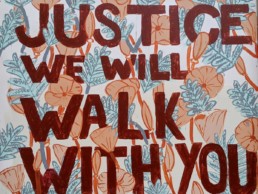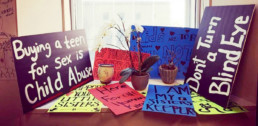FAQs
In order for us to be able to change the system that allows sex trafficking and exploitation of children to occur, we need to be equipped with the right information. We’ve compiled some frequently asked questions to help you better understand the key issues, terms and individuals that are involved with the commercial sexual exploitation of children. Knowledge is power, so please take a moment to read through these questions to get started.

What is human trafficking?
The U.S. Department of Justice defines human trafficking as “a crime that involves the exploitation of a person for the purposes of compelled labor or a commercial sex act through the use of force, fraud, or coercion. When a person younger than 18 is induced to perform a commercial sex act, it is a crime regardless of whether there is any force, fraud, or coercion.”
What is commercial sexual exploitation of children?
Commercial sexual exploitation of children (CSEC) is any sexual activity involving sex for an exchange for something of value, or promise thereof, to the child or another person or persons. The child is treated as commercial and sexual property. Examples of exploitation include pornography, stripping, escort services, gang-based prostitution, private parties and street prostitution. CSEC is a form of violence against children.
Who are the victims of CSEC?
Victims of child exploitation are under the age of 18 and can be of any ethnicity, race, religion, socioeconomic class, gender, and sexual orientation. Children who are most vulnerable to exploitation are those who live in communities that struggle with violence, poverty and disenfranchisement., They have extensive abuse histories and have grown up around adults who themselves have experienced abuse, struggle with mental health, and addiction to drugs or alcohol.
Are victims of CSEC recognized as victims of rape or abuse?
Sexual exploitation and sex trafficking are forms of child abuse, but in most states, the children and adolescents who are victims can still be arrested for prostitution, detained or incarcerated, and subject to permanent records as offenders. This is not true for California.

Who are the youth MISSSEY works with?
At MISSSEY, the majority of our participants are Black girls from low-income communities in Alameda County. The youth we serve are ages 12-24, 97% identify as female and 3% identify as transgender female, 73% are African/African American/Black, 12% Latinx/Hispanic, 4% White/European American (11% Declined To State/Unknown). They come to us through the justice system, social services, the foster care system, the education system, peers, and self-referrals. Many of the girls we serve are systems-involved, struggle with poverty, lack strong family supports, and have suffered previous physical, sexual, and mental abuse and neglect.
What is MISSSEY’s approach to supporting victims of CSEC?
MISSSEY uses a healing centered and trauma informed approach that focuses on harm reduction, positive youth development and supporting youth through change.
Why do some victims of CSEC not seek help?
Victims of sexual exploitation often feel that they have no safe place to go to for help. They are isolated from family and friends, may feel ashamed or embarrassed to confide in their loved ones, or have no support system in place to get the help they need. Sometimes victims are imprisoned by their exploiter/trafficker and are unable to escape due to threats and/or physical abuse. Exploited youth can also be groomed by exploiters to distrust systems designed to support them and may not be aware of existing services. Or, they may distrust systems because they have bad experiences of systems and have experienced harm when involved with systems meant to support them.
Who are the exploiters/traffickers?
Pimps and johns (purchasers/buyers) are exploiters. Pimps recruit and profit off of the youth they sexually exploit, and johns pay to sexually exploit the youth. Purchasers range across all demographics but they are usually male. Children are actually more likely to be trafficked by someone who knows them, such as a family member, “boyfriend,” friend or co-worker.

What is human trafficking?
The U.S. Department of Justice defines human trafficking as “a crime that involves the exploitation of a person for the purposes of compelled labor or a commercial sex act through the use of force, fraud, or coercion. When a person younger than 18 is induced to perform a commercial sex act, it is a crime regardless of whether there is any force, fraud, or coercion.”
What is commercial sexual exploitation of children?
Commercial sexual exploitation of children (CSEC) is any sexual activity involving sex for an exchange for something of value, or promise thereof, to the child or another person or persons. The child is treated as commercial and sexual property. Examples of exploitation include pornography, stripping, escort services, gang-based prostitution, private parties and street prostitution. CSEC is a form of violence against children.
Who are the victims of CSEC?
Victims of child exploitation are under the age of 18 and can be of any ethnicity, race, religion, socioeconomic class, gender, and sexual orientation. Children who are most vulnerable to exploitation are those who live in communities that struggle with violence, poverty and disenfranchisement., They have extensive abuse histories and have grown up around adults who themselves have experienced abuse, struggle with mental health, and addiction to drugs or alcohol.
Are victims of CSEC recognized as victims of rape or abuse?
Sexual exploitation and sex trafficking are forms of child abuse, but in most states, the children and adolescents who are victims can still be arrested for prostitution, detained or incarcerated, and subject to permanent records as offenders. This is not true for California.


